What Makes a Book a 'Classic'?
A quick look at literary criticism. Plus: classics and literary fiction from India, and a book that may already be one of my favorite reads of 2024
Last week we had the chance to chat with Sara and Chelsey from
in a special bonus episode of the podcast: How to Read Like an English Teacher. We had so much fun talking about our childhood favorites, what makes a book a classic, and how we can read more deeply.This post is a special bonus edition of The Novel Tea Newsletter - in addition to our bimonthly posts, from time to time you will receive additional content relating to our bonus podcast episodes, book recommendations, and other cultural commentary. In the future, these bonus newsletters may only be available to paid subscribers, but for now, we are excited to share with you a sample of what this bonus content will look like.
Towards the end of the episode, Sara and Chelsey asked us what we would consider the great classics from India. Readers, I didn’t have an answer ready. While I have read a good amount of fiction by Indian authors and diaspora writers, and could name some classics, I realized that I have been so deeply entrenched in the English language that I haven’t taken enough time to look into India’s own literary traditions, which are rich and varied.
Though I conduct my life in English, and it is the language I am most comfortable in, it was not my first language. For the first three years of my life, I spoke only Kannada, a South Indian language quite distinct from Indo-European tongues. Living in the United States, I sadly transitioned into speaking only English, and my Kannada now remains at the 1st grade level.
It made me think - how much have I been colonized, in my life, language, and reading?
Over the holidays, I tried to find works in translation from South Asia, but in speaking to my parents, I learned that many lauded works in India’s languages have not even been translated into English. This made me sad, that I may never read some of the world’s greatest writing.
Still, I did my best to uncover some lesser known works, so below you’ll find recommendations for literary fiction from the Indian Subcontinent, including ancient classics, modern classics, and works in translation - with discussions about their importance, why we should read them, and what we can learn from them.
But first, I want to take some time to consider the term ‘classic.’
How Do We Define a Classic?
Historically, the “classics” we are familiar with have been prescribed by academics of the Ivory Tower. Dickens, Dante, and Brontë are on most lists, but names from outside the Western world rarely make an appearance. Only recently have scholars started to give equal importance to writers like Borges, Morrison, and Achebe. But our lens is still pretty white, straight, and Western (we’ve talked before about the kinds of books that we are exposed to from other countries).
This was one of our driving motivations in creating The Novel Tea podcast - to find and discuss diverse classics that more completely represent the human experience.
So at the end of each episode, we ask ourselves: “will this book stand the test of time?” And over the past year of podcasting, this question has contained many other questions - is this a book we’d like to share with future generations? Is this a book with an important lesson? Is it a book that subverts expectations and challenges the status quo? Is this a book with universal themes that anyone can connect with? Or is just so damn good that you can’t put it down?
I loved the definition that Chelsey and Sara shared with us on our bonus episode:
“A classic is a book that never finishes saying what it has to say”
I also enjoyed this list of Italo Calvino’s criteria for what makes a classic, taken from his essay Why Read the Classics?
But Calvino wasn’t the first author to consider this question - writers and thinkers have been trying to answer this question for centuries.
What is a Classic? Looking at Literary Criticism
French literary critic Charles Augustin Sainte-Beuve, in his 18th century essay “What is a Classic?”1 shares his definition as:
an author who has enriched the human mind, increased its treasure, and caused it to advance a step; who has discovered some moral and not equivocal truth, or revealed some eternal passion in that heart where all seemed known and discovered…
These words sound nice, but for me, they don’t help much in answering the question. I like the theories propounded by TS Eliot much more.
In 1944, Eliot delivered an address to the Virgil Society titled “What is a Classic?”2 In it, he argues that for a work to be a classic, it must demonstrate maturity:
A classic can only occur when a civilisation is mature; when a language and literature are mature; and it must be the work of a mature mind.
By his argument, Austen’s novels are classics not just because they contain something inherently insightful, but also because we can see the progression of her style and themes from the early Sense and Sensibility to the later Persuasion. To Eliot, it is not any one individual work that signals a classic. It is the process and evolution of a literary tradition that is important -
Maturity of mind: this needs history, and the consciousness of history. Consciousness of history cannot be fully awake, except where there is other history than the history of the poet’s own people: we need this in order to see our own place in history.
For Eliot, a classic speaks “to all classes and conditions of men” and is, crucially, a culmination or representative work of a particular culture, literary tradition, or civilization. Eliot’s arguments (which you can read in full here) inspire me to read geographically - to consider multiple works simultaneously within their cultural contexts, and then broaden the scope to ask what they say about humanity as a whole.
With this in mind, let’s take a look at some ancient and modern classics from the Indian subcontinent.
An Ancient Classic from India
VALMIKI’S RAMAYANA translated by Arshia Sattar
Time period: approx 200-2 BCE
Original language: Sanskrit
In Season 2 of the podcast, we had a great time discussing the Mahabharata through two retellings, The Palace of Illusions and The Great Indian Novel - we got to dig deep into the characters, morals, and different versions of the story, and as a result, I think it has become my favorite epic. But over the winter I read The Forest of Enchantments, a retelling of the Ramayana, and it has inspired me to read the original text.
The Ramayana is an epic comparable in scale to The Odyssey - though its story, themes, and morals are entirely different. Central to the story are two characters: Rama, the heir apparent who is banished by his father’s wife to prevent him from ascending to the throne, and Sita, his wife, who, halfway through their exile, is kidnapped by a strange villain. As we read this story in the 21st century, questions arise on right vs. wrong, duty, loyalty, and love.
This version, translated by Arshia Sattar (who holds a PhD in South Asian Languages and Civilization from the University of Chicago), is widely regarded as the most authoritative, and the most readable. In addition to this translation, she has written multiple analytic books on the Ramayana, such as Lost Loves: Exploring Rama’s Anguish, which explores Rama’s later actions in the story and attempts to come to terms with it. I can’t wait to read her translation, and follow it up with some of her scholarly work.
If you are interested in literary criticism of the Indian epics, you can also check out Yuganta: The End of an Epoch, which looks at the Mahabharata from an anthropological and historical lens.
One of My Favorite Reads of the Year (Already): Cuckold
Inventive storytelling and unique narration in a modern classic
Even if you read nothing else in this newsletter - read this review.
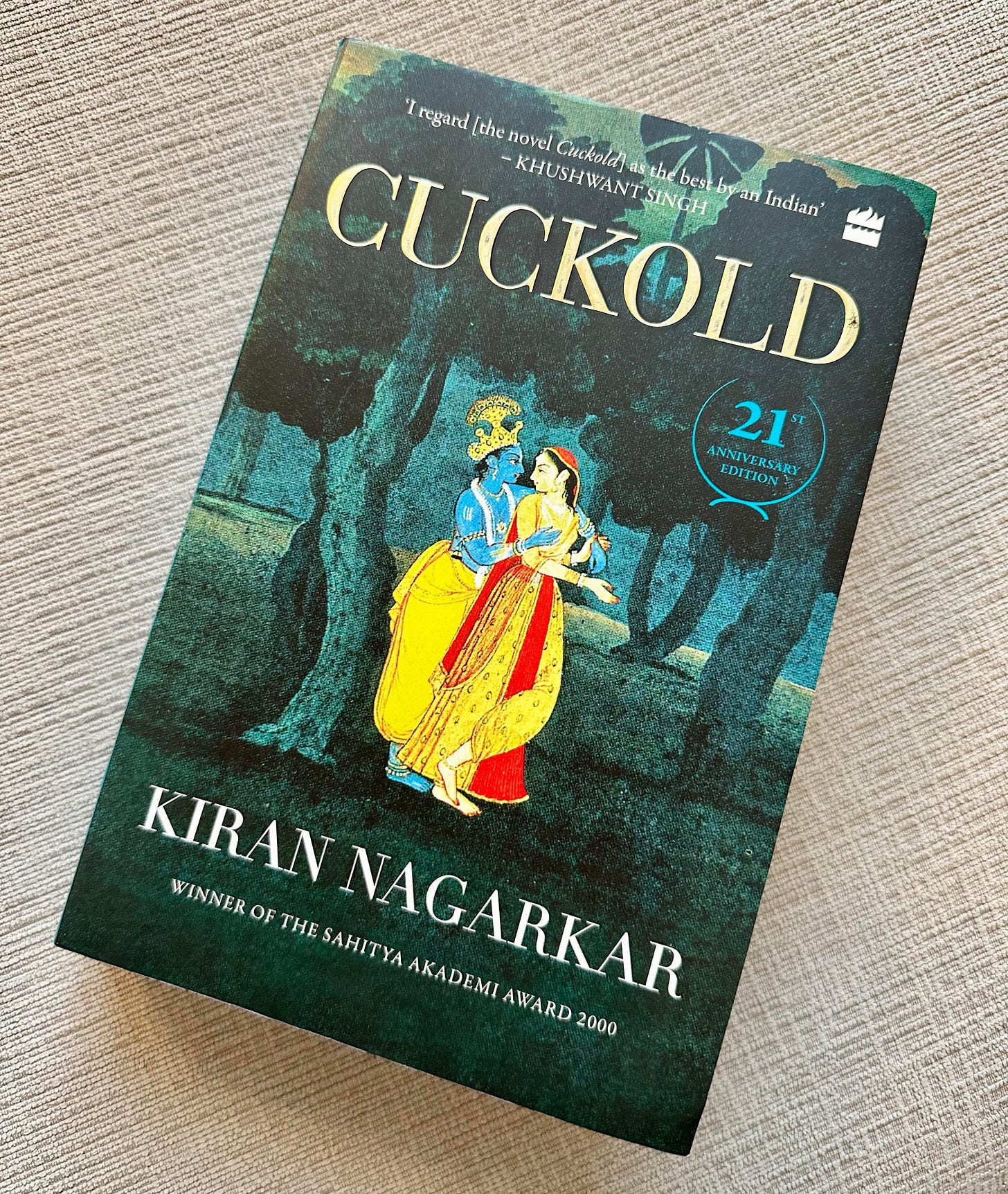
Mirabai is a name as familiar to Indians as Emily Dickinson is to the English. In translated lines from one of her poems, she writes:
Friends, let those whose Beloved is absent write letters—
Mine dwells in the heart, and neither enters nor leaves.
Mirabai was a devotee of Krishna, for whom she wrote hundreds of poems and songs - but beyond this, we know very little about what her life was like. The few details we do know are that she was a Rajput princess, and when she was young, she was wed to a prince of the House of Sisodia, Bhoj Raj. The novel Cuckold is about this prince.
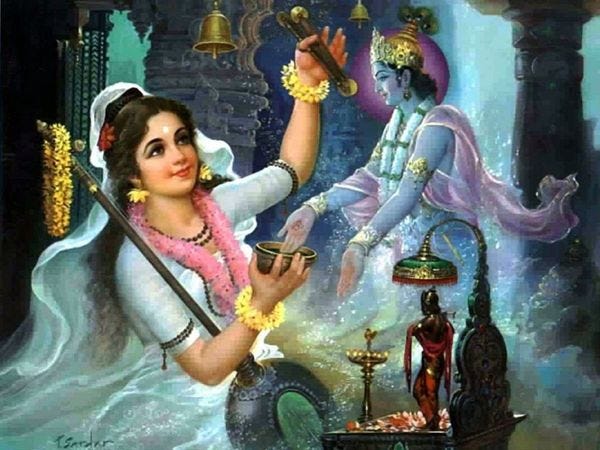
When the book starts, in the years before the first Mughal emperor, Babur, invades Delhi, Bhoj Raj (called Maharaj Kumar) is the heir apparent, the eldest son, and an important army commander of Mewar. Over the next 600 pages, we get to know the Maharaj Kumar, his goals for the Rajput state, his marriage to Mirabai and rage at being cuckolded by a God, his political machinations, the palace scandals he becomes mired in, and much more.
Cuckold is such an interior novel - we get detailed information on Maharaj Kumar’s thoughts and motivations because most of the novel is told in the first person; but then, this is brilliantly upended by what we see of him in the occasional chapters that are written in the third person. In these third person chapters, he is rash, violent, unpredictable, and at times cruel. But in the first person chapters, he is thoughtful, cautious, intelligent - even caring. So who is the protagonist of this novel? It is rare that I come away from a novel without a clear answer to this question.
Is the Maharaj Kumar a good person? Is he a bad person? Is there even such a distinction?
The story somehow exists on a timeless plane: the writing jumps between past and present tense, sometimes even within the same paragraph. Yet it is not jarring - it all flows together smoothly, and leaves the reader to wonder about the interconnectedness of stories. Anecdotes and opinions on today’s world sneak into the book, making the far-away 16th century Rajasthan feel as modern and important as the current day. This book is based on historical events, yes, but its ideas and its philosophy speak to the modern soul.
At times, there are wonderful moments of self-awareness that shine through. In one passage, the narrator describes the process of writing his autobiography; but what is really happening is that Nagarkar himself is reaching out and describing the process of writing a book.
And, one of my favorite things about the book: Nagarkar’s narrative voice is stunning. He rebels against the Western maxim of simplicity of prose, mixing metaphors and idioms and using complicated sentence structures and an expansive vocabulary. What results is not bloated, heavy phrases, but rather, lush evocative descriptions that made me want to climb into the pages of the book.
Particularly noteworthy were his descriptions of the battlefield and classical music. From page 366:
My wife called out to the sun, her song was impatient and imperious. But it could also implore and plead, use any kind of guile to push aside the rock-clouds. I closed my eyes.
She changed her tactics. Her voice grew soft and sinuous and hinted at secret trysts. It ingratiated itself into the chinks and fissures, became frisky and intimate and slipped in and out of the rock precipice in the sky. It withdrew into the cellars and underworlds of the earth, lingered like mist and then started back. It gained momentum rapidly, wave rolled into urgent wave, fought its way out into the open, built into a roaring wall of water that would brook no obstacle and hurled itself at the black impregnable dome. Nothing happened. Then there was a fearsome creaking sound and the sky tottered and crashed down. The sun broke through the temple, not a nascent, tentative one but a full-blown, unstoppable golden orb. The carvings, the pillars, the mandapas, the staggered levels of the temple, the full marble structure and the two of us inside turned into light. My wife’s song was pure joy. The temple tilted, and we were airborne. We flew at the speed of light and were at the heart of the stillness that is the universe.
Have you ever read such a beautiful, dynamic description of what music sounds like, and what it makes us feel?
Even with all its technical brilliance, its use of language, and inventive structure, Cuckold is also a good story. How does the Maharaj deal with a wife who wants nothing to do with him? With rising political threats coming from three different directions? With evidence of treason from within the walls of the palace?
I could go on and on - about the importance of the color green, the obsession that the Maharaj develops with his enemy Babur and how they mirror each other, the levels of the battles that Maharaj Kumar is waging on state, devotional, familial, and personal levels - but this review must end eventually.
Maybe part of what made this book so special was the feeling that I discovered it. I learned about Cuckold somewhat by accident, stumbling upon it online while looking for something else, and went into it with no expectations. And sometimes the best things happen by accident.
I have never read a book quite like this one. It feels different from every other novel that has come before it, and every novel that will come after it.
Modern Classics & Literary Fiction from the Indian Subcontinent
The Guide by R. K. Narayan
The Guide follows Raju, a corrupt but likeable tour guide, who meets and falls in love with Rosie, a young dancer - and by the end of his journey he becomes one of the most respected holy men of India. We hear his story in alternations of past and present, slowly learning about the different characters, and how Raju has transformed from a travel guide into a spiritual guide.
Narayan was one of India’s major literary figures of the 20th century, and lived through a time of tremendous change. Published a decade after India’s official independence, The Guide touches on cultural, industrial, and political transformations through its characters and thematic explorations.
[Also: The Guide was adapted into a widely acclaimed movie in 1965, directed by Vijay Anand.]
Such a Long Journey by Rohinton Mistry
In 1971, India was at war with what is now Bangladesh - but this book is not about the soldiers and politicians; it is about ordinary people. Gustad Noble, a Parsi man living in Mumbai, is watching his life change: his daughter is ill, his son isn’t following his path, and the neighborhood seems to be devolving into chaos. But then he receives a call for help from an old friend, and he is drawn into new troubles.
Beautifully written and skillfully paced, nothing I can say about the plot of this novel will adequately capture its charm. Mistry is honest about the struggles his characters face, but he is kind to them, and provides them all with dignity. While A Fine Balance is my favorite of Mistry’s works, I think Such a Long Journey is the best entry into his novels.
River of Fire by Qurratulain Hyder
Originally published in Urdu as ‘Aag Ka Darya’ in 1959, the English translation River of Fire is now available for a whole new audience. Spanning two and a half millenia and covering four Indian epochs, the novel traces four souls over time: Gautum, Champa, Kamal, and Cyril. Each new embodiment carries the same name as their predecessor. Meditating on history and human nature, while interweaving parables, myths, dreams, and letters, the book redefines what a novel can be.
This is the only book on this list that I have not yet read, but I cannot wait to dig into it. From what I’ve read about it, it seems to be steeped in the Indian, not Western, literary tradition (much like Cuckold), and I’m excited to immerse myself in that style.
— Shruti
Up Next
Next on the podcast, we’ll be discussing The Secret History. We absolutely loved reading this book and we can’t wait to share all our reactions and theories! The episode will be out on February 21 on all podcast platforms.
Sainte-Beuve, Charles Augustine. “What Is A Classic?” The Harvard Classics 32 (1909): n". pag. Bartleby.com. 17 Apr. 2001. Web. 6 Feb. 2024.
Eliot, Thomas S. “What is a Classic?” Address. The Virgil Society. London, UK. 16 Oct. 1944. http://bracchiumforte.com. CJ Armstrong. Web. 6 Feb. 2024.





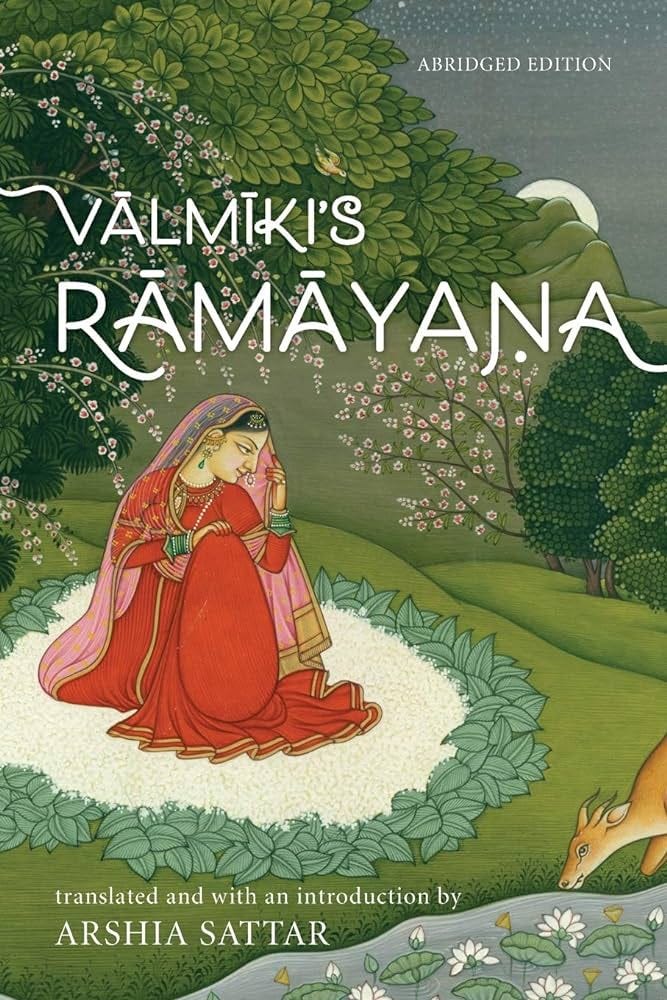
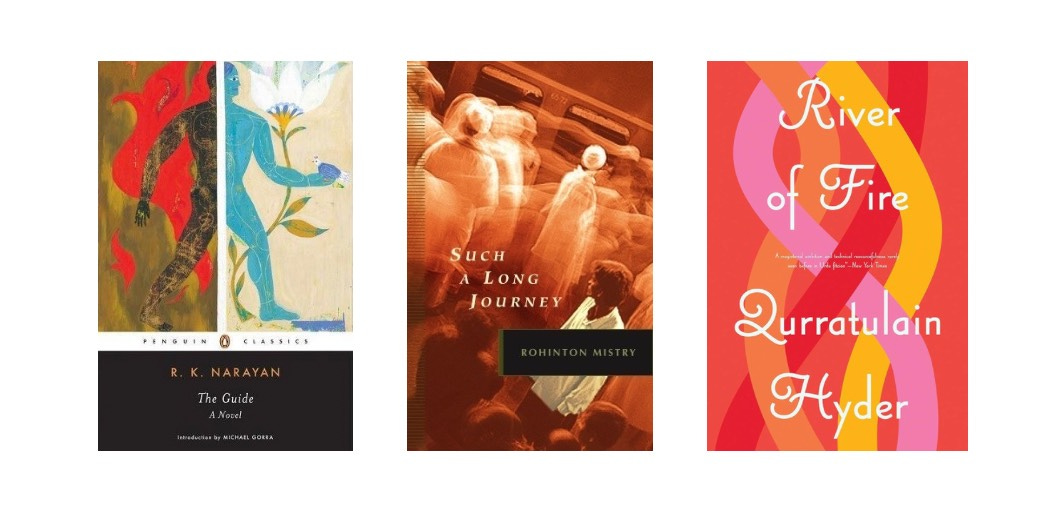
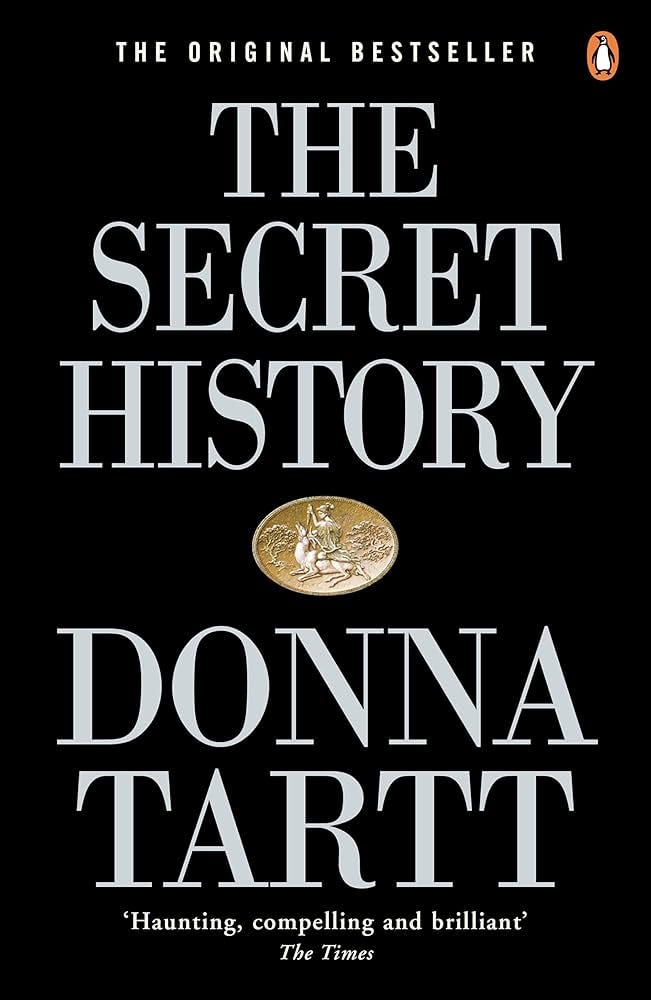
Really enjoyed your discussion with the Novel Pairings ladies!